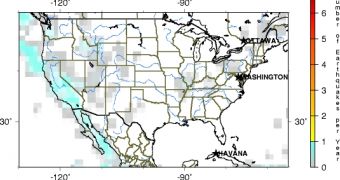A new governmental report warns that numerous Southern and Midwestern states, including Illinois, Alabama, Tennessee, Indiana, Kentucky, Mississippi, Missouri and Arkansas, are at significant risk of being severely affected by a potential large-scale earthquake. The states are on top of a high-intensity seismic area, which has been named the New Madrid Seismic Zone (NMSZ).
The earthquake that was used in the simulations that prompted the release of the new report had a 7.7 magnitude on the Richter scale, and scientists working on the predictive model also used information about the architecture and structural integrity strength of homes, commercial buildings, bridges and other structures in elaborating their conclusions.
Federal Emergency Management Agency (FEMA) spokeswoman, Mary Margaret Walker, said in a statement that "People who live in these areas and the people who build in these areas certainly need to take into better account that at some time there is (...) expected to be a catastrophic earthquake in that area, and they'd better be prepared for it."
The region that could be struck by this major earthquake is currently home to some 44 million people, and FEMA warns that the number of human casualties could be very high. In 1811-12, when the last major tremors occurred in the region, casualties were limited, because this portion of the US was sparsely populated. However, at the time, the Mississippi river shifted its course, because of the earthquake.
In the event of a natural disaster, the damages done to the infrastructure would imply thousands of buildings severely damaged or brought down, as well as impaired hospitals and police stations, much like it recently happened in China. The National Guard says that such conditions would favor the appearance of anarchy, and that authorities may lose control of the situation, as looters would appear.
Hopefully, based on this study, federal authorities would recommend new building standards to architects and construction companies, ones that would ensure minimal destruction in the eventuality of such a tremor. However, existing buildings need to be reinforced, as this disaster could occur at any time, knowing that some 100 years have passed since the last time a major tremor struck the region.

 14 DAY TRIAL //
14 DAY TRIAL //